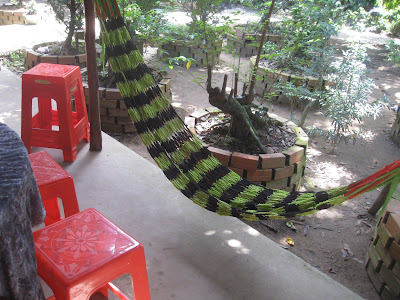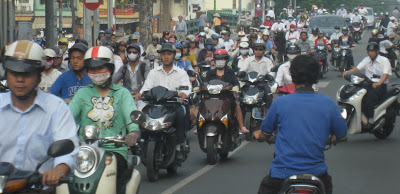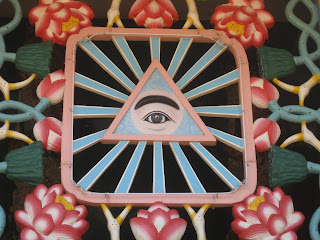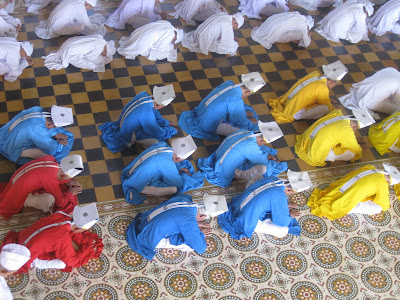The North gets almost all the press (Hanoi, Sapa, Halong Bay), but spending some time in the South is also a great experience. After our night at the beach in Mui Ne we returned to Ho Chi Minh City (aka Saigon) for a couple of nights--at the beginning of our trip we had just slept there overnight before flying directly on to Hanoi. Two interesting things along the 4-hour drive from the beach to the city: first, miles of dragonfruit orchards--strange-looking foliage with equally odd-looking fruit hanging from it; open it up and you find a pretty pink rind topped by white pulp with black speckles on the inside. Nice flavor too! We ate dragonfruit for breakfast almost every morning of our trip.
 |
| Dragonfruit--like eating a dalmatian with pink skin |
The second unusual feature of the drive was the hundreds of small, privately owned rest stops where you could pull over for refreshments and a hammock break. Wouldn't it be nice if U.S. rest stops had hammocks too?
 |
| I've never seen a hammock I didn't want to be in |
Ho Chi Minh City was a lot less daunting after 23 days traveling around the country. Yes, HCMC surely takes the top prize for the highest concentration of motobikes in the world, but it seemed so much calmer than it did when we first arrived. Do I dare say we've gotten used to the motorbike overload?
 |
| 5 million ... and counting |
The city has a lot going for it--there's a modern, vibrant feel to it that was not as noticeable in Hanoi. Young people flock here for jobs, shopping, and entertainment. Everybody is doing something, going someplace. There's great shopping at modern stores (the clothes are especially nice in the district 1 shops), tons of restaurants and coffee shops, but also thriving Vietnamese street life of the more traditional sort. For example, right outside our modern hotel (the Sanouva) street vendors cook and serve noodles and veggies to passersby morning and night.

We checked off a couple of tourist musts. Visited the lovely main post office with its old maps painted on the walls and a big portrait of Ho Chi Minh looking down over the customers. The building is old, in the French style (designed by Gustave Eiffel), and many of the original features have been retained even while the postal business goes on, uninterrupted by the tourists snapping photos.
Across the street is Notre Dame Cathedral--a brick version of the Parisian landmark, sans buttresses. There are actually quite a few Catholic churches in HCMC and the Mekong area, but many of them are built in a pseudo-Asian style that makes you look twice when you see a cross on the building.
We also took in the Cholon district, Chinatown, which has lots of pagodas as well as a big wholesale market selling birds nests for soup, shark fins (ugh), and sundry other goods in bulk. After the market we stopped in at the very active Thien Hau temple where lots of praying was going on despite the crowds of tourists gawking at the hanging incense coils and other temple features.
 |
| Hanging incense coils burn in memory of ancestors for a couple of weeks |
 |
| Le makes like a Vietcong--put the top down and disappear |
A couple more days in the city itself would have been nice since there are many museums and pagodas to see, but instead we headed out onto the delta on a day trip to the Cu Chi tunnels and to the town of Tay Ninh, about two hours from downtown HCMC. The tunnels were a famous part of the Vietnam war, spanning a large area very close to the city. Here the Vietcong controlled the countryside through a series of narrow passages and larger underground living areas. The area was thoroughly bombed by the Americans and was the scene of repeated attempts to eliminate the Vietcong presence. The area of the tunnels we visited has been restored so visitors can get some idea of what it was like during the war. We found it extremely interesting. We went early in the day (left HCMC at 7:30 a.m.) so it wasn't overrun with tourists, who generally crowd the trails a little later in the day. After we watched a propaganda film from the late '60s (Americans were foreign devils, etc.) and saw various exhibits of life in and around the tunnels, we walked, hunched over, through a very narrow underground trail section. We went only about 30 meters, but it was enough to convince me that I would not have done well as a tunnel dweller during the war. Or ever.

Tay Ninh is home to the head church of the Cao Dai religion. I'm intrigued by different people's religious beliefs and how they are expressed, so this place was really interesting. The religion was established in 1928, combining elements of Catholicism, Confucianism, and Taoism, and seems to appeal mainly to rural residents of southern Vietnam (we saw lots of Cao Dai temples south of HCMC). The head church is decorated with dragon columns and bright primary colors--blue, red, and yellow--but the most noticeable feature is the star-laden globe altar with a big eye looking at the followers. Many other eyes adorn the walls. We observed the 30-minute noon prayer ceremony (similar ceremonies take place 4 times a day, every day except for the 3 days around the lunar new year), which involved a small orchestra of Vietnamese instruments and lots of chanting by a female choir while the couple hundred worshippers sat cross-legged in orderly fashion on the floor, bowing their heads in unison every so often at certain points in the chant. Men and women were grouped separately. The strangest part of the religion for me is the choice of saints: a Vietnamese poet, French writer Victor Hugo, and Chinese republican leader Sun Yat-sen. Quite a mix.
 |
| Cao Dai elders during the prayer service |
We returned to HCMC for the night but headed out again the next morning for a two-day exploration of the Mekong Delta. The river dominates life in this area, and we were able to get a sense of the place by taking several different sizes of boats over the course of the two days. The wide, main river section is busy with boat traffic--all varieties of produce, sand, petrol, tourists, you name it--and we spent most of our time on a long, covered motorboat with the standard noisy engine. But we were also able to go through some of small canals on a quiet rowboat, which was really nice.
 |
| Quiet time on a Mekong canal |
Last night we stayed in the small city of Can Tho, right along the river, and really enjoyed seeing the locals relaxing and exercising in the park along the river in the cooler evening temperatures. A few games of foot badminton were going on, too (a cross between hacky sack and badminton).

This morning we got up at 6 a.m. and took a boat downriver (or was it upriver?) to the Can Tho floating market, where boats from surrounding areas and even other provinces gather every morning to sell their produce to Can Tho residents. Each boat that is selling something hoists that product (watermelon, pumpkin, taro, onion, pineapple, whatever) up on a bamboo pole over the boat so that buyers, on smaller boats, can easily see which boats to go to for what. Our guide told us that the market has been getting smaller year by year, mainly because of the cost of petrol for the boats--it's apparently cheaper to bring the produce to market in other ways.
 |
| Longan, a small fruit with a big seed |
The drive back to HCMC took about 4 hours, including a stop for lunch at a large, nicely run rest stop/shopping opportunity/restaurant, which serves most of the tour groups, large and small, that travel from the delta to city. It's a thriving operation that must make a ton of money for the owner, who is already very powerful in the area, according to our guide. Pretty good food though, including one of the specialties of the delta: elephant ear fish wrapped in (edible) rice paper with lettuce, pineapple, and rice noodles.
 |
| All wrapped up and ready to eat |
So that's a wrap for our 24-day trip to Vietnam. It's been a pleasure. Never got tired of the food--there was always something different to try, and it was usually very good. The scenery was varied and often incredibly beautiful. The weather was quite nice in the north and got warmer as we went south; afternoons in HCMC and on the delta were best spent inside an air-conditioned space, though mornings and evenings were comfortable and great times for walking around. The people we met were universally friendly and welcoming. Our accommodations-- with the exception of the hotel we stayed at in Lai Chau, in the far northwest--were all modern, very comfortable, and reasonably priced. Our guides were terrific, though some were easier to understand than others. The drivers were great (Mr. Driver's gearshift problems aside). We really enjoyed Vietnam and are so glad to have been able to spend a good chunk of time here, getting to know the country from top to bottom.
Next stop: Siem Reap, Cambodia



